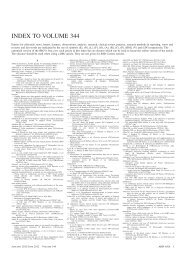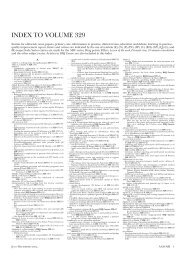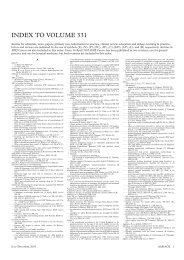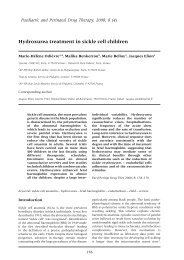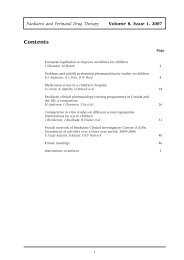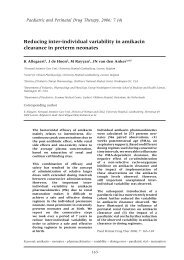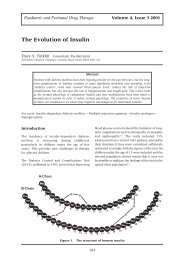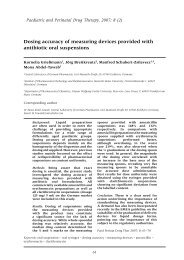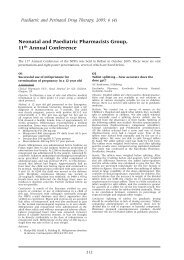Adverse drug reactions in Nigerian children - BMJ Group
Adverse drug reactions in Nigerian children - BMJ Group
Adverse drug reactions in Nigerian children - BMJ Group
You also want an ePaper? Increase the reach of your titles
YUMPU automatically turns print PDFs into web optimized ePapers that Google loves.
Paediatric and Per<strong>in</strong>atal Drug Therapy, 2007; 8 (2)<br />
<strong>Adverse</strong> <strong>drug</strong> <strong>reactions</strong> <strong>in</strong> <strong>Nigerian</strong> <strong>children</strong><br />
K A Oshikoya 1,2 , O F Njokanma 2 , H A Chukwura 3 , I O Ojo 3<br />
1 Pharmacology and Therapeutics Department, Lagos State University College of Medic<strong>in</strong>e, Ikeja, Lagos, Nigeria<br />
2 Paediatrics and Child Health, Lagos State University Teach<strong>in</strong>g Hospital, Ikeja, Lagos, Nigeria<br />
3 Pharmacy Department, Lagos State University Teach<strong>in</strong>g Hospital, Ikeja, Lagos, Nigeria<br />
Correspond<strong>in</strong>g author<br />
Dr K A Oshikoya, Pharmacology and Therapeutics Department, Lagos State University College of Medic<strong>in</strong>e, PMB 21266, Ikeja,<br />
Lagos, Nigeria. Email: med_modhospital@yahoo.com<br />
Aims: Children constitute a vulnerable<br />
group with regard to rational <strong>drug</strong><br />
prescrib<strong>in</strong>g s<strong>in</strong>ce many new <strong>drug</strong>s<br />
are marketed for their use without<br />
evidence from cl<strong>in</strong>ical trials. The<br />
paucity of <strong>in</strong>formation about the<br />
<strong>in</strong>cidence of adverse <strong>drug</strong> <strong>reactions</strong><br />
(ADRs) <strong>in</strong> develop<strong>in</strong>g countries,<br />
especially Nigeria has necessitated this<br />
study. The study was therefore aimed<br />
at document<strong>in</strong>g the types of ADRs <strong>in</strong><br />
<strong>children</strong> admitted to the Lagos State<br />
University Teach<strong>in</strong>g Hospital, Ikeja.<br />
Methods: It was both a retrospective and<br />
prospective study. The retrospective<br />
study was performed from January<br />
2004 to June 2006. The prospective<br />
study <strong>in</strong>volved all patients admitted to<br />
the <strong>children</strong>’s ward for various forms<br />
of paediatric medical conditions over<br />
a 6 month period between July and<br />
December 2006. Suspected ADRs noted<br />
<strong>in</strong> the hospital records were used for the<br />
retrospective study. For the prospective<br />
study pharmacovigilance by a multidiscipl<strong>in</strong>ary<br />
team was performed.<br />
Keywords: adverse <strong>drug</strong> <strong>reactions</strong> – <strong>children</strong> – antibiotics – sk<strong>in</strong> <strong>reactions</strong><br />
81<br />
Results: 3139 <strong>children</strong> were admitted<br />
to the <strong>children</strong>’s ward over the<br />
30 month retrospective study and<br />
682 <strong>children</strong> were admitted over<br />
the 6 month prospective study.<br />
Altogether, 17 <strong>children</strong> (0.4%)<br />
were admitted due to ADRs and<br />
27 <strong>children</strong> (0.7%) experienced an<br />
ADR <strong>in</strong> hospital. Antibiotics were<br />
the group of <strong>drug</strong>s most likely to<br />
be associated with an ADR. Sk<strong>in</strong><br />
<strong>reactions</strong> were the most frequent<br />
ADR. Two <strong>children</strong> died as a result of<br />
their ADR.<br />
Conclusion: ADRs are a signifi cant<br />
problem <strong>in</strong> <strong>children</strong> <strong>in</strong> Nigeria. We<br />
conclude that a functional monitor<strong>in</strong>g<br />
and report<strong>in</strong>g system for ADRs <strong>in</strong><br />
<strong>children</strong> needs to be put <strong>in</strong> place for<br />
early detection. Such a scheme will<br />
hopefully result <strong>in</strong> <strong>in</strong>creased awareness<br />
amongst health professionals and<br />
parents about reduc<strong>in</strong>g the risk of an<br />
ADR.<br />
Paed Per<strong>in</strong>at Drug Ther 2007; 8: 81-88
Paediatric and Per<strong>in</strong>atal Drug Therapy, 2007; 8 (2)<br />
Introduction<br />
Globally physicians are faced everyday with<br />
problems of adverse <strong>drug</strong> <strong>reactions</strong> (ADRs) 1-3<br />
and about 95% of such cases go unreported<br />
worldwide 4,5 . All <strong>drug</strong>s have the potential<br />
to cause ADRs. Some medic<strong>in</strong>es, such as<br />
antibiotics 6-9 , immunosuppressive agents 7<br />
and anticonvulsants 10-12 are more likely to be<br />
associated with ADRs <strong>in</strong> <strong>children</strong>. In Nigeria, a<br />
high rate of antibiotic prescription and misuse<br />
and polypharmacy has been reported <strong>in</strong> both<br />
urban and rural health facilities 13-15 , thus plac<strong>in</strong>g<br />
<strong>Nigerian</strong> <strong>children</strong> at a high risk of ADRs.<br />
The actual reported <strong>in</strong>cidence of ADRs varies<br />
accord<strong>in</strong>g to the population described and the<br />
case defi nition used 16-18 , the method used, the<br />
vigour with which ADRs are sought, as well as<br />
the number of concomitantly adm<strong>in</strong>istered <strong>drug</strong>s<br />
to produce <strong>drug</strong> <strong>in</strong>teractions 17-20 .<br />
Febrile illnesses <strong>in</strong> <strong>children</strong> constitute a common<br />
presentation <strong>in</strong> Nigeria and other countries <strong>in</strong> sub-<br />
Saharan Africa 21,22 , the major cause be<strong>in</strong>g malaria<br />
and respiratory tract <strong>in</strong>fections. The majority of<br />
these <strong>children</strong> are usually treated at home either<br />
with antimalarials alone 23,24 or <strong>in</strong> comb<strong>in</strong>ation<br />
with antibiotics when upper respiratory tract<br />
<strong>in</strong>fections were suspected by the parents 13 .<br />
Antibiotic utilisation <strong>in</strong> upper respiratory tract<br />
<strong>in</strong>fections is not peculiar only to self medications<br />
by <strong>Nigerian</strong> mothers, but is a common practice<br />
amongst general practitioners 25,26 , primary health<br />
care workers 27,28 , tertiary and teach<strong>in</strong>g hospitals<br />
physicians 14,15 . The irrational use of antimalarials<br />
and antibiotics not only predisposes patients to<br />
<strong>drug</strong> resistance, but also places them at risk of<br />
ADRs 15,29 . Co-trimoxazole and ampicill<strong>in</strong> are two<br />
commonly prescribed antibiotics <strong>in</strong> the <strong>Nigerian</strong><br />
primary health care centres 28 and are associated<br />
with ADRs manifest<strong>in</strong>g as morbilliform rash 30 .<br />
Other identifi ed risk factors to develop<strong>in</strong>g ADRs<br />
<strong>in</strong> <strong>Nigerian</strong> <strong>children</strong> <strong>in</strong>clude environmental<br />
factors, polypharmacy, pre-exist<strong>in</strong>g diseases,<br />
previous ADRs, medication errors, <strong>in</strong>appropriate<br />
prescrib<strong>in</strong>g and long periods of hospitalisation 31 .<br />
ADRs are ranked as one of the top lead<strong>in</strong>g causes<br />
of death and illness <strong>in</strong> the developed world 17 .<br />
However, there is a paucity of <strong>in</strong>formation about<br />
its <strong>in</strong>cidence <strong>in</strong> develop<strong>in</strong>g countries, especially<br />
Nigeria. This study was therefore aimed at<br />
document<strong>in</strong>g ADRs <strong>in</strong> <strong>children</strong> admitted to Lagos<br />
State University Teach<strong>in</strong>g Hospital (LASUTH),<br />
Ikeja, Nigeria. An ADR monitor<strong>in</strong>g committee was<br />
established <strong>in</strong> this hospital and became effective<br />
shortly before we commenced the prospective<br />
study. In addition to report<strong>in</strong>g <strong>in</strong>cidences of ADRs,<br />
we also wished to compare detection of ADRs<br />
82<br />
before and after the <strong>in</strong>ception of the monitor<strong>in</strong>g<br />
committee.<br />
Methods<br />
The study was both retrospective and prospective.<br />
The retrospective study was performed through<br />
the hospital’s admission records. The admission<br />
records for the period from January 2004 to June<br />
2006 were used to identify <strong>children</strong> with an ADR<br />
(either on admission or as an <strong>in</strong>patient). The<br />
prospective study <strong>in</strong>volved all patients admitted to<br />
the <strong>children</strong>’s ward for various paediatric medical<br />
conditions over a six month period between July<br />
and December 2006. For both studies, patients<br />
admitted for less than 24 hours and those with<br />
repeated admissions were excluded from the<br />
study.<br />
For the prospective study, on each day of the study<br />
period, a specifi c questionnaire was completed<br />
for all <strong>children</strong> newly admitted. All <strong>children</strong> were<br />
evaluated daily for the presence of ADRs by the<br />
research team (cl<strong>in</strong>ical pharmacologist, paediatrician<br />
and pharmacists) and were observed until<br />
discharge to ascerta<strong>in</strong> the fi nal diagnosis. The<br />
evaluation was usually carried out about two hours<br />
before the normal ward rounds. The evaluation<br />
consisted of exam<strong>in</strong><strong>in</strong>g medical and nurs<strong>in</strong>g records,<br />
review<strong>in</strong>g prescription charts and attend<strong>in</strong>g cl<strong>in</strong>ical<br />
rounds. All the paediatricians and junior doctors<br />
were asked to participate <strong>in</strong> the study and to record<br />
any suspected ADRs.<br />
If a suspected ADR was reported, data on that<br />
particular suspected <strong>drug</strong> and reaction were<br />
collected and documented <strong>in</strong> a suitably designed<br />
ADR documentation form. All relevant data,<br />
<strong>in</strong>clud<strong>in</strong>g all <strong>drug</strong>s the patient had received<br />
before the onset of the reaction, their respective<br />
doses, the routes of adm<strong>in</strong>istration with their<br />
frequency, laboratory test results present <strong>in</strong><br />
medical records, cl<strong>in</strong>ical details (system–organ<br />
class <strong>in</strong>volvement), and the treatment (pharmacological<br />
or non-pharmacological) were noted.<br />
In addition, when the documented <strong>drug</strong> history<br />
was unclear, the patient’s medication history<br />
was taken from the patients or parents/guardians<br />
or the attend<strong>in</strong>g physicians, and co-morbidity<br />
was identifi ed to assess the causal relationship<br />
between the suspected <strong>drug</strong> and the reaction.<br />
In the retrospective study, the same documentation<br />
form was completed for the patients<br />
who experienced an ADR. Therefore, this study<br />
was done on three separate populations: those<br />
admitted to the hospital because of an ADR <strong>in</strong><br />
the prospective study; those who experienced an<br />
ADR <strong>in</strong> the hospital <strong>in</strong> the prospective study; and<br />
those admitted for, or who developed, an ADR <strong>in</strong><br />
the retrospective study.
For the prospective study, <strong>in</strong>formation regard<strong>in</strong>g<br />
previous <strong>drug</strong> use was obta<strong>in</strong>ed by <strong>in</strong>terview<strong>in</strong>g<br />
parents, relatives, nurses, or others, as necessary.<br />
ADRs were defi ned <strong>in</strong> accordance with the WHO<br />
defi nition of an ADR 32 . A pharmacist, pharmacologist<br />
and paediatric dermatologist acted as<br />
a fi nal source of confi rm<strong>in</strong>g an ADR. The ADRs<br />
and <strong>drug</strong>s were classifi ed accord<strong>in</strong>g to the WHO<br />
classifi cation 33 . The causality relationship <strong>in</strong><br />
the prospective study between the ADR and<br />
the suspected <strong>drug</strong> therapy was assessed case<br />
by case us<strong>in</strong>g the method of Jones 34 . To ensure<br />
that patients with ADRs had not been missed<br />
out <strong>in</strong> the retrospective study, we analysed 200<br />
random case notes of patients categorised as<br />
not hav<strong>in</strong>g had an ADR. Severity was classifi ed<br />
accord<strong>in</strong>g to the follow<strong>in</strong>g scheme: fatal; severe<br />
(directly life-threaten<strong>in</strong>g and/or more than one<br />
month <strong>in</strong> duration, associated with organ-system<br />
dysfunction, reduced life expectancy); moderate<br />
(some but not all of the mild criteria and none<br />
of the severe criteria); and mild (uncomplicated<br />
primary disease, no treatment required, and <strong>drug</strong><br />
discont<strong>in</strong>uation not necessary) 35-38 .<br />
The ethical committee of LASUTH approved<br />
the study. All data from the questionnaires<br />
and medical records were coded and statistical<br />
analysis of the results was performed us<strong>in</strong>g SPSS<br />
version 13. Cont<strong>in</strong>uous data were analysed us<strong>in</strong>g<br />
Student’s t-test at a signifi cance level of P < 0.05.<br />
Results<br />
3139 <strong>children</strong> were admitted to the <strong>children</strong>’s<br />
ward of LASUTH dur<strong>in</strong>g the 30 month retrospective<br />
study, of whom 1844 (59%) were males.<br />
682 <strong>children</strong> were admitted dur<strong>in</strong>g the six month<br />
prospective study, of whom 386 (57%) were<br />
males. The admission rate per month rema<strong>in</strong>ed<br />
Paediatric and Per<strong>in</strong>atal Drug Therapy, 2007; 8 (2)<br />
83<br />
relatively constant <strong>in</strong> both the retrospective and<br />
prospective studies (105/month vs 114/month).<br />
Dur<strong>in</strong>g the retrospective study period, 13 <strong>children</strong><br />
were admitted due to ADRs and 17 <strong>in</strong>patients<br />
developed ADRs. The mean age of the patients<br />
admitted with ADRs was 7.2 years (age range, 6<br />
months–12 years) and was signifi cantly higher<br />
than the mean age (3.9 years; range, 2 days–12<br />
years) for the <strong>in</strong>patients that developed ADRs (P<br />
= 0.017).<br />
Dur<strong>in</strong>g the prospective study, four <strong>children</strong><br />
(0.6%) were admitted follow<strong>in</strong>g ADRs and 10<br />
(1.5%) <strong>in</strong>patients developed ADRs. The mean age<br />
of the patients admitted with ADRs was 6.7 years<br />
(age range, 3–10 years) and was not signifi cantly<br />
different from the mean age 3.1 years (range,<br />
2 days–10 years) for the <strong>in</strong>patients that developed<br />
ADRs (P = 0.11).<br />
The patients admitted for the prospective study<br />
had a wide variety of diseases. The ma<strong>in</strong> reason<br />
for admission was malaria (n = 247, 36%),<br />
followed by men<strong>in</strong>gitis (n = 77, 11%). The 682<br />
patients received a total of 3032 <strong>drug</strong>s dur<strong>in</strong>g<br />
hospitalisation (4.5 <strong>drug</strong>s per patient; range,<br />
2–10). The most commonly used <strong>drug</strong>s were<br />
cefuroxime and gentamic<strong>in</strong>. The 10 <strong>in</strong>patients<br />
from the prospective study that developed ADRs<br />
were prescribed a total of 51 <strong>drug</strong>s (mean 5.1<br />
<strong>drug</strong>s per patient, range 4–10).<br />
Comb<strong>in</strong>ed data<br />
The <strong>in</strong>cidence of ADRs result<strong>in</strong>g <strong>in</strong> admission was<br />
0.45% and dur<strong>in</strong>g hospitalisation was 0.71%.<br />
Overall, 44 <strong>children</strong> (1.15%) experienced ADRs.<br />
Among the patients with ADRs, fi ve <strong>children</strong><br />
had a previous history of ADRs but not to the<br />
suspected <strong>drug</strong>s.<br />
Table 1 Systemic-organ classes of adverse <strong>drug</strong> <strong>reactions</strong> and the suspected <strong>drug</strong>s<br />
Types of reaction<br />
Cutaneous manifestation<br />
Suspected <strong>drug</strong>s n<br />
Erythema multiforme Cotrimoxazole (5), Phenobarbitone (4), Ampicill<strong>in</strong> (5), Sulphadox<strong>in</strong>e/Pyrimetham<strong>in</strong>e (4) 14<br />
Pustular rash Baby oil (8), Vancomyc<strong>in</strong> (2) 10<br />
Fixed <strong>drug</strong> eruption Sulphadox<strong>in</strong>e/Pyrimetham<strong>in</strong>e (1), Cotrimoxazole (1) 2<br />
Stevens Johnson syndrome Cotrimoxazole (1), Sulphadox<strong>in</strong>e/Pyrimetham<strong>in</strong>e (1), Ampicill<strong>in</strong> (1), Phenobarbitone (1) 2<br />
Macular and morbiliform rash Ampicill<strong>in</strong> 1<br />
Urticaria rash Ceftriaxone 1<br />
Papulo-nodular rash<br />
Systemic manifestation<br />
Isoniazid 1<br />
Fever Ceftriaxone (1), Ceftazidime (1) 2<br />
Red Man syndrome Vancomyc<strong>in</strong> (2) 2<br />
Anaphylactic shock Ceftriaxone 1<br />
Hyperbilirub<strong>in</strong>aemia<br />
CNS manifestation<br />
Ceftriaxone 1<br />
Dystonia Promethaz<strong>in</strong>e (1), Metroclopramide (1) 2<br />
Transient loss of vision Qu<strong>in</strong><strong>in</strong>e (2) 2<br />
Hepatic encephalopathy Herbal <strong>drug</strong> 1<br />
Convulsion Herbal concoction 1<br />
Irrational behaviour Halofantr<strong>in</strong>e 1<br />
Total 44
Paediatric and Per<strong>in</strong>atal Drug Therapy, 2007; 8 (2)<br />
Twenty eight ADRs were considered to be defi nite,<br />
12 probable and four possible. Most ADRs (n =<br />
34) shown <strong>in</strong> this study were classifi ed as type A<br />
ADRs, accord<strong>in</strong>g to the classifi cation of Rawl<strong>in</strong>s<br />
and Thompson 16 . Forty three were judged to<br />
be preventable. Eleven ADRs were directly<br />
responsible for the prolongation of the hospital<br />
stay (range, 18–30 days).<br />
Table 1 summarises the ADRs detected accord<strong>in</strong>g<br />
to the organ-system affected. The most common<br />
cl<strong>in</strong>ical manifestation of an ADR dur<strong>in</strong>g the study<br />
period was erythema multiforme rash (14 cases),<br />
followed by pustular rash (10 cases). In total,<br />
50 <strong>drug</strong>s were <strong>in</strong>crim<strong>in</strong>ated <strong>in</strong> the occurrence of<br />
the 44 ADRs (Table 1). The 50 <strong>drug</strong>s consisted<br />
of the follow<strong>in</strong>g types of <strong>drug</strong>s: antibiotics 24,<br />
antimalarials n<strong>in</strong>e, baby oil eight, anticonvulsants<br />
fi ve, herbal <strong>drug</strong>s and others four.<br />
Twenty two of the ADRs were severe, of which<br />
two resulted <strong>in</strong> death, 18 were moderate, and<br />
four mild (Tables 2 and 3). Most of the survivors<br />
recovered without long-term sequelae. One child<br />
Table 2 <strong>Adverse</strong> <strong>drug</strong> <strong>reactions</strong> <strong>in</strong> admitted cases<br />
ADR Co-morbidity Drug Parental Age Sex Severity Duration of Duration of<br />
presumed (years) ADR before admission<br />
Prospective<br />
diagnosis presentation<br />
(days)<br />
(days)<br />
Erythema M. Epilepsy ***Phenobarbitone Nil 6 M Severe 2 8<br />
Erythema M. Nil *Sulphadoxime /<br />
Pyrimetham<strong>in</strong>e<br />
URTI, Malaria 10 M Severe 2 21<br />
Erythema M. Malnutrition *Co-trimoxazole URTI 12 M Severe 5 28<br />
Macular and<br />
morbiliform rash<br />
Retrospective<br />
Nil *Ampicill<strong>in</strong> Diarrhoea 2 F Moderate 2 7<br />
Erythema M. Epilepsy ***Phenobarbitone<br />
*Ampiclox<br />
*Multivitam<strong>in</strong>e<br />
*Calam<strong>in</strong>e lotion<br />
Measles 10 M Severe 4 22<br />
Erythema M. Nil **Ampicill<strong>in</strong><br />
**Gentamic<strong>in</strong><br />
*Cefuroxime<br />
Tonsillitis 4 M Severe 1 9<br />
Erythema M. Nil *Sulphadoxime /<br />
Pyrimetham<strong>in</strong>e<br />
Malaria 7 F Severe 7 21<br />
Erythema M. HIV <strong>in</strong>fection ***Co-trimoxazole - 10 M Severe 2 10<br />
Erythema M. Epilepsy ***Phenobarbitone<br />
*Ampicill<strong>in</strong><br />
URTI 6 F Severe 2 30<br />
Erythema M. Nil *Ampicill<strong>in</strong><br />
*Sulphadoxime /<br />
Pyrimetham<strong>in</strong>e<br />
Malaria, URTI 4 M Severe 7 30<br />
Erythema M. Nil ***Sulphadoxime /<br />
Pyrimetham<strong>in</strong>e<br />
Malaria 6 F Severe 3 20<br />
Erythema M. Malnutrition *Co-trimoxazole URTI 6 M Severe 3 30<br />
Erythema M. Nil *Ampicill<strong>in</strong><br />
*Co-trimoxazole<br />
URTI 5 F Severe 7 18<br />
SJS Nil +Cotrimoxazole<br />
+Sulphadoxime /<br />
Pyrimetham<strong>in</strong>e<br />
++Chloramphenicol<br />
++Proca<strong>in</strong>e penicill<strong>in</strong><br />
++Ampicill<strong>in</strong><br />
Malaria, Typhoid 8 M Severe 3 Died 3 days later<br />
Hepatic failure Nil *Herbal <strong>drug</strong> Haemorrhoids 0.5 M Severe 3 Died 5 days later<br />
Irrational behaviour Nil ++Halofanthr<strong>in</strong>e Malaria 7 M Moderate 1 5<br />
Convulsion Nil *Herbal concoction Malaria 3 F Moderate 30 m<strong>in</strong>s 5<br />
Erythema M. = Erythema multiforme **Prescribed at primary health care centre<br />
URTI = Upper respiratory tract <strong>in</strong>fection ***Prescribed at LASUTH outpatient cl<strong>in</strong>ic<br />
SJS = Stevens Johnson syndrome +Prescribed by tra<strong>in</strong>ed unregistered nurse<br />
*Self medication (non-prescribed <strong>drug</strong>) ++Prescribed by general practitioners <strong>in</strong> private cl<strong>in</strong>ics/hospitals<br />
84<br />
died from liver failure due to the use of herbal<br />
medic<strong>in</strong>es and another died from Stevens Johnson<br />
Syndrome (SJS) due to antibiotics. The most<br />
frequent severe ADR was erythema multiforme.<br />
The erythema multiforme was characterised by<br />
multiple and extensive complex sk<strong>in</strong> rashes that<br />
<strong>in</strong>volved the mucous membrane. Exfoliation and<br />
peel<strong>in</strong>g of the sk<strong>in</strong> resulted <strong>in</strong> the debility and<br />
prolonged hospitalisation of the patients. Most of<br />
the sk<strong>in</strong> lesions healed with permanent hyperpigmentations.<br />
The two cases of SJS had a similar<br />
presentation to erythema multiforme, except for<br />
greater mucocutaneous <strong>in</strong>volvement, associated<br />
per<strong>in</strong>eal and oral mucosal peel<strong>in</strong>g, hyphaemia and<br />
alopecia. One patient later developed unioccular<br />
bl<strong>in</strong>dness.<br />
The anaphylaxis to ceftriaxone and ceftazidime<br />
(two <strong>children</strong>) was similar to the Red Man<br />
syndrome (shock) <strong>in</strong>duced by vancomyc<strong>in</strong> (two<br />
<strong>children</strong>). The patients developed diffi culty <strong>in</strong><br />
breath<strong>in</strong>g, excessive sweat<strong>in</strong>g, palpitations, chest<br />
pa<strong>in</strong>, cold and clammy extremities, and weak<br />
thready pulse follow<strong>in</strong>g rapid adm<strong>in</strong>istration of
Table 3 <strong>Adverse</strong> <strong>drug</strong> <strong>reactions</strong> <strong>in</strong> <strong>in</strong>-patients who developed ADRs<br />
ADR Co-morbidity Diagnosis on Age Sex Severity Duration of Suspected <strong>drug</strong>s Other <strong>drug</strong>s<br />
admission treatment<br />
prior to ADR<br />
Prospective<br />
Erythema M. Nil Cerebral abscess 6 months M Severe 6 days Ampicill<strong>in</strong>, Phenobarbitone Ceftriaxone<br />
Red Man syndrome Nil Osteomyelitis 3 years M Severe 10 m<strong>in</strong>s Vancomyc<strong>in</strong> Chloramphenicol<br />
Red Man syndrome Nil Osteomyelitis 6 years F Severe 2 days Vancomyc<strong>in</strong> Chloramphenicol<br />
Dystonia Nil Malaria 12 years M Moderate 8 hours Promethaz<strong>in</strong>e Chloroqu<strong>in</strong>e,<br />
Paracetamol<br />
Dystonia Nil Gastroenteritis 2 years F Moderate 6 hours Metoclopramide Artesunate<br />
Pustular rash Neonate Sepsis 3 days M Moderate 2 days Baby oil Cefuroxime, Gentamic<strong>in</strong><br />
Pustular rash Neonate Sepsis 3 days F Moderate 3 days Baby oil Cefuroxime, Gentamic<strong>in</strong><br />
Pustular rash Prematurity Sepsis 2 days F Moderate 2 days Vancomyc<strong>in</strong> Gentamic<strong>in</strong><br />
Pustular rash Prematurity Sepsis 2 days F Moderate 2 days Vancomyc<strong>in</strong> Gentamic<strong>in</strong><br />
Paediatric and Per<strong>in</strong>atal Drug Therapy, 2007; 8 (2)<br />
Retrospective<br />
SJS Nil Men<strong>in</strong>gitis 6 years M Severe 7 days Ampicill<strong>in</strong>, Phenobarbitone Chloramphenicol<br />
Erythema M. HIV Gastroenteritis 8 years F Severe 3 days Co-trimoxazole<br />
Pustular rash Neonate Sepsis 2 days M Moderate 2 days Baby oil Cefuroxime, Gentamic<strong>in</strong><br />
Pustular rash Neonate Sepsis 4 days M Moderate 3 days Baby oil Cefuroxime, Gentamic<strong>in</strong><br />
Pustular rash Neonate Sepsis 2 days F Moderate 3 days Baby oil Cefuroxime, Gentamic<strong>in</strong><br />
Pustular rash Prematurity Sepsis 3 days F Moderate 2 days Baby oil Cefuroxime, Gentamic<strong>in</strong><br />
Pustular rash Prematurity Sepsis 2 days M Moderate 2 days Baby oil Cefuroxime, Gentamic<strong>in</strong><br />
Pustular rash Prematurity Sepsis 4 days M Moderate 3 days Baby oil Cefuroxime, Gentamic<strong>in</strong><br />
Jaundice Hyperbilirub<strong>in</strong>aemia Birth asphyxia, sepsis 4 days M Severe 3 days Ceftriaxone Gentamic<strong>in</strong><br />
Anaphylaxis Nil Septicaemia 11 years F Severe 20 m<strong>in</strong>s Ceftriaxone<br />
Urticaria Nil Septicaemia 8 years M Severe 10 m<strong>in</strong>s Ceftriaxone<br />
Fixed <strong>drug</strong> eruption Nil Shigellosis 12 years M Mild 4 days Cotrimoxazole<br />
Fixed <strong>drug</strong> eruption Nil Malaria 10 years F Mild 3 days Sulphadoxime / Pyrimetham<strong>in</strong>e Artesunate<br />
Papulo-nodular rash Nil TB men<strong>in</strong>gitis 6 months M Moderate 5 days Isoniazid Rifampic<strong>in</strong>, Pyraz<strong>in</strong>amide<br />
Fever Nil Septicaemia 4 months F Mild 3 days Ceftazidime<br />
Fever Nil Septicaemia 6 months F Mild 7 days Ceftriaxone<br />
Transient bl<strong>in</strong>dness Nil Cerebral malaria 4 years M Moderate 6 days Qu<strong>in</strong><strong>in</strong>e Dexamethasone<br />
Transient bl<strong>in</strong>dness Nil Cerebral malaria 6 years M Moderate 7 days Qu<strong>in</strong><strong>in</strong>e Dexamethasone<br />
85<br />
Erythema M. = Erythema multiforme<br />
SJS = Stevens Johnson syndrome
Paediatric and Per<strong>in</strong>atal Drug Therapy, 2007; 8 (2)<br />
the <strong>drug</strong>s <strong>in</strong>travenously. They were revived by<br />
active resuscitation and rehydration. The <strong>in</strong>fant<br />
with hyperbilirub<strong>in</strong>aemia required an urgent<br />
exchange blood transfusion and phototherapy.<br />
The 18 moderate ADRs <strong>in</strong>cluded 10 cases<br />
of pustular rash to adulterated baby oil and<br />
vancomyc<strong>in</strong>, two cases of dystonia, and two cases<br />
of transient loss of vision from qu<strong>in</strong><strong>in</strong>e. There was<br />
no permanent deformity or debility to the patients,<br />
except the papulo-nodular sk<strong>in</strong> rashes from<br />
isoniazid that rema<strong>in</strong>ed permanent. The pustular<br />
rash required treatment with corticosteroids. The<br />
irrational behaviour and dystonia were treated<br />
with benztrop<strong>in</strong>e, and the convulsion controlled<br />
with rectal diazepam.<br />
Of the 17 <strong>children</strong> admitted due to ADRs<br />
(Table 2), n<strong>in</strong>e cases resulted from the use of nonprescribed<br />
<strong>drug</strong>s, i.e. self-medicated <strong>drug</strong>s from<br />
the parents, three cases from the use of <strong>drug</strong>s<br />
prescribed <strong>in</strong> the community, four cases from the<br />
use of prescribed <strong>drug</strong>s from LASUTH paediatric<br />
outpatient cl<strong>in</strong>ic, and one case from the use of a<br />
prescribed <strong>drug</strong> at LASUTH that <strong>in</strong>teracted with<br />
a self-medicated <strong>drug</strong>. Antibiotics, used alone or<br />
<strong>in</strong> comb<strong>in</strong>ation, resulted <strong>in</strong> ADRs <strong>in</strong> 10 <strong>children</strong><br />
admitted follow<strong>in</strong>g ADRs and 14 <strong>in</strong>patients.<br />
Discussion<br />
The data result<strong>in</strong>g from this study offer an <strong>in</strong>sight<br />
for health professionals <strong>in</strong>to the impact of ADRs <strong>in</strong><br />
a develop<strong>in</strong>g country <strong>in</strong> the sett<strong>in</strong>g of a <strong>Nigerian</strong><br />
paediatric population. The overall <strong>in</strong>cidence<br />
of ADRs lead<strong>in</strong>g to admission was 0.45% and<br />
0.71% patients follow<strong>in</strong>g admission developed<br />
an ADR. These rates were low when compared<br />
with results (2.1% and 9.5% respectively) from<br />
developed countries 7,9 , thus suggest<strong>in</strong>g that ADRs<br />
are under-reported <strong>in</strong> develop<strong>in</strong>g countries.<br />
Under-report<strong>in</strong>g may have resulted from a lack of<br />
awareness of ADRs and a lack of facilities for their<br />
proper monitor<strong>in</strong>g. Similarly, when the <strong>in</strong>cidence<br />
rates were compared with the results (5.1%<br />
and 10.9% respectively) from adult sett<strong>in</strong>gs <strong>in</strong><br />
developed countries 17,39-41 , they were also very<br />
low thus suggest<strong>in</strong>g that ADRs are less common<br />
<strong>in</strong> <strong>children</strong> than adults 9,17,18 . The higher <strong>in</strong>cidence<br />
rates obta<strong>in</strong>ed from the prospective study over<br />
the retrospective study may be expla<strong>in</strong>ed by the<br />
daily monitor<strong>in</strong>g for ADRs. A proactive ADR<br />
monitor<strong>in</strong>g and report<strong>in</strong>g system, focus<strong>in</strong>g on<br />
paediatric patients <strong>in</strong> develop<strong>in</strong>g countries appears<br />
to be successful.<br />
The most commonly affected organ system was<br />
the sk<strong>in</strong> (over 50% of ADRs). The most frequently<br />
reported ADR was a rash which was similar to the<br />
fi nd<strong>in</strong>gs of other studies 35,42-44 . The group of <strong>drug</strong>s<br />
86<br />
most frequently <strong>in</strong>volved <strong>in</strong> ADRs <strong>in</strong> our study<br />
was antibiotics. Infectious diseases were, however,<br />
the commonest cause for admission to hospital<br />
and hence antibiotics were frequently prescribed.<br />
Erythema multiforme, the most common ADR <strong>in</strong><br />
this study, was caused by antibiotics (ampicill<strong>in</strong><br />
and cotrimoxazole), antimalarials (sulfadoxime/<br />
pyrimetham<strong>in</strong>e) and anticonvulsants (phenobarbitone).<br />
These <strong>drug</strong>s are well known for this<br />
type of ADR 30,45 . The high <strong>in</strong>crease of erythema<br />
multiforme was probably a result of the pattern<br />
of self-medicated and prescribed <strong>drug</strong>s used by<br />
the patients (Tables 2 and 3). In those patients<br />
who developed ADRs from a comb<strong>in</strong>ation of two<br />
or more <strong>drug</strong>s, the sk<strong>in</strong> manifestation was either<br />
erythema multiforme or its severe form, SJS, and<br />
they were hospitalised for over two weeks.<br />
ADRs are of signifi cant concern <strong>in</strong> that two<br />
<strong>children</strong> died dur<strong>in</strong>g the course of this study. It<br />
was, however, diffi cult to determ<strong>in</strong>e from this<br />
study the fatality rate of the ADRs because of the<br />
small population studied. This is therefore one of<br />
the limitations of this study. One of the deaths<br />
resulted from use of herbal medic<strong>in</strong>e conta<strong>in</strong><strong>in</strong>g<br />
naphthalene tablets as one of the <strong>in</strong>gredients.<br />
Renal failure complicat<strong>in</strong>g the use of herbal<br />
medic<strong>in</strong>es has been previously reported <strong>in</strong> Africa 46 .<br />
Severe jaundice, anaemia, haemolysis, hepatic<br />
encephalopathy and renal failure, as manifested<br />
by this patient, are a few of the manifestations<br />
of chronic toxicity of naphthalene 47 . It can be<br />
concluded that ADRs are a signifi cant public<br />
health problem <strong>in</strong> <strong>children</strong>.<br />
Self-medication was a common fi nd<strong>in</strong>g among<br />
the patients hospitalised for ADRs and this<br />
<strong>in</strong>volved the use of <strong>drug</strong>s that have the potential<br />
for adverse <strong>in</strong>teractions. The use of 5.1 <strong>drug</strong>s per<br />
patient on admission that developed ADRs <strong>in</strong> the<br />
prospective study was consistent with the reports<br />
of other studies 48,49 . This high <strong>drug</strong> use is termed<br />
polypharmacy. An association between the<br />
number of <strong>drug</strong>s received by <strong>children</strong> and the risk<br />
of ADRs has been previously reported 9,42,49,50 .<br />
Conclusion<br />
We conclude that ADRs are not a rare problem<br />
<strong>in</strong> Nigeria. Even though they are under-reported<br />
worldwide, they are much more under-reported<br />
<strong>in</strong> Nigeria. A functional monitor<strong>in</strong>g and report<strong>in</strong>g<br />
system for ADRs <strong>in</strong> <strong>children</strong> therefore needs to be<br />
put <strong>in</strong> place for early detection. A public enlightenment<br />
programme is advised <strong>in</strong> order to stem the<br />
tide of self-medications amongst <strong>Nigerian</strong> mothers<br />
s<strong>in</strong>ce many of these <strong>drug</strong>s have the potential for<br />
adverse <strong>in</strong>teractions that could cause unwanted<br />
<strong>drug</strong> <strong>reactions</strong>. The Government should regulate<br />
the sales and use of herbal medic<strong>in</strong>es for <strong>children</strong>.
Physicians should familiarise themselves with the<br />
pharmacology of the commonly used <strong>drug</strong>s <strong>in</strong><br />
<strong>children</strong> and weigh the benefi t–risk ratio before<br />
prescrib<strong>in</strong>g.<br />
References<br />
1. Pirmohamed M, Park BK. <strong>Adverse</strong> <strong>drug</strong> <strong>reactions</strong>:<br />
back to the future.Br J Cl<strong>in</strong> Pharmacol. 2003;55:<br />
486-492.<br />
2. Dorman H, Muth-Selbach U, Krebs S, et al.<br />
Incidence and costs of adverse <strong>drug</strong> <strong>reactions</strong><br />
dur<strong>in</strong>g hospitalization: computerized monitor<strong>in</strong>g<br />
versus stimulated spontaneous report<strong>in</strong>g. Drug Saf<br />
2000;25:161-168.<br />
3. Rieder M. <strong>Adverse</strong> <strong>drug</strong> <strong>reactions</strong>. The Canadian<br />
Journal of CME. 2002;83-91.<br />
4. Institute of Medic<strong>in</strong>e (US). To err is human:<br />
Build<strong>in</strong>g a Safer health system. Kohn LT, Corrigan<br />
JM, Donaldson MS, eds. Wash<strong>in</strong>gton: The Institute;<br />
2000.<br />
5. Fletcher AP. Spontaneous adverse <strong>drug</strong> report<strong>in</strong>g<br />
vs event monitor<strong>in</strong>g: a comparison. J R Soc Med<br />
1991;84:341-344.<br />
6. Jonville-Bera AP, Giraudeau B, Blanc P, Beau-<br />
Sal<strong>in</strong>as F, Autret-Leca E. Frequency of adverse <strong>drug</strong><br />
<strong>reactions</strong> <strong>in</strong> <strong>children</strong>: a prospective study. Br J Cl<strong>in</strong><br />
Pharmacol 2002;53:207-210.<br />
7. Weiss J, Krebs S, Hoffmann C et al. Survey of<br />
adverse <strong>drug</strong> <strong>reactions</strong> on paediatric ward: a strategy<br />
for early detailed detection. Pediatrics 2002;110:<br />
254-257.<br />
8. Pirmohamed M. Anticipat<strong>in</strong>g, <strong>in</strong>vestigat<strong>in</strong>g and<br />
manag<strong>in</strong>g the adverse effects of <strong>drug</strong>s. Cl<strong>in</strong> Med<br />
2005;5:23-25.<br />
9. Impicciatore P, Choonara I, Clarkson A, Provasi D,<br />
Pandolfi ni C, Bonati M. Incidence of adverse <strong>drug</strong><br />
<strong>reactions</strong> <strong>in</strong> paediatric <strong>in</strong>/out-patients: a systematic<br />
review and meta-analysis of prospective studies. Br<br />
J Cl<strong>in</strong> Pharmacol 2001;52:77-83.<br />
10. Clarkson A, Ingleby E, Choonara I, Bryan P,<br />
Arlett P. A novel scheme for the report<strong>in</strong>g of adverse<br />
<strong>drug</strong> <strong>reactions</strong>. Arch Dis Child 2001;84:337-339.<br />
11. Kemp A, S<strong>in</strong>gh-Grewal D, Wong M. A prospective<br />
study of the immediate and delayed adverse events<br />
follow<strong>in</strong>g <strong>in</strong>travenous immunoglobul<strong>in</strong> <strong>in</strong>fusions.<br />
Arch Dis Child 2006;91:651-654.<br />
12. Le J, Nguyen T, Law AV, Hodd<strong>in</strong>g J. <strong>Adverse</strong> <strong>drug</strong><br />
<strong>reactions</strong> among <strong>children</strong> over a 10- year period.<br />
Pediatrics 2006;118:555-562.<br />
13. Olayemi SO, Oreagba I, Onajole AT, Ajekigbe AT.<br />
Antimicrobial prescription patterns <strong>in</strong> urban and<br />
rural primary health facilities <strong>in</strong> South Western<br />
Nigeria. Nig Med Pract 2005;47:82-86.<br />
14. Nwolisa CE, Er<strong>in</strong>augha EU, Ofoleta SI, 2006.<br />
Prescrib<strong>in</strong>g practices of doctors attend<strong>in</strong>g to under<br />
fi ves <strong>in</strong> a <strong>children</strong>’s outpatient cl<strong>in</strong>ic <strong>in</strong> Owerri,<br />
Nigeria. J Trop Paediatr 2006;52:197-200.<br />
15. Oshikoya KA, Chukwura HA, Ojo IO. Evaluation<br />
of outpatient paediatric <strong>drug</strong> prescriptions <strong>in</strong> a<br />
teach<strong>in</strong>g hospital <strong>in</strong> Nigeria for rational prescription<br />
Paed Per<strong>in</strong>at Drug Ther 2006;7:183-188.<br />
16. Rawl<strong>in</strong>s MD, Thompson JW. Mechanisms of adverse<br />
<strong>drug</strong> <strong>reactions</strong>. In: Davies DM. Ed. Textbook of<br />
adverse <strong>drug</strong> <strong>reactions</strong>. Oxford: Oxford University<br />
Press, 1991:18-45.<br />
17. Lazarou J, Pomeranz BH, Corey PN. Incidence<br />
of adverse <strong>reactions</strong> <strong>in</strong> hospitalized patients:<br />
a meta-analysis of prospective studies. JAMA<br />
1998;279:1200-1205.<br />
Paediatric and Per<strong>in</strong>atal Drug Therapy, 2007; 8 (2)<br />
87<br />
18. Clarkson A, Conroy S, Burroughs K, Choonara I.<br />
Surveillance for adverse <strong>drug</strong> <strong>reactions</strong> <strong>in</strong> <strong>children</strong>:<br />
a paediatric regional monitor<strong>in</strong>g centre. Paed<br />
Per<strong>in</strong>atal Drug Ther 2004;6:20-23.<br />
19. Pouyanne P, Haramburu F, Imbs JL, Begaud<br />
B.Admissions to hospital caused by adverse<br />
<strong>drug</strong> <strong>reactions</strong>: cross-sectional <strong>in</strong>cidence study.<br />
French Pharmacovigilance Centres. Br Med J<br />
2000;320:1036.<br />
20. Hallas J, Harvard B, Gram LF, et al. Drug related<br />
hospital admissions: the role of defi nitions and<br />
<strong>in</strong>tensity of data collection and possibility of<br />
prevention. J Intern Med 1990;228:83-90.<br />
21. Sule SS. Childhood morbidity and treatment<br />
pattern at the multipurpose health centre Ilesa,<br />
Nigeria. Niger J Med 2003;12:145-149.<br />
22. Ansah EK, Gyapong JO, Agyepong IA, Evan<br />
DB. Improv<strong>in</strong>g adherence to malaria treatment<br />
for <strong>children</strong>: the use of pre-packed chloroqu<strong>in</strong>e<br />
tablets vs. chloroqu<strong>in</strong>e syrup. Trop Med Int Health<br />
1996;6:496-504.<br />
23. Ajayi IO, Falade CO. Pre-hospital treatment of<br />
febrile illness <strong>in</strong> <strong>children</strong> attend<strong>in</strong>g the general<br />
outpatients’ cl<strong>in</strong>ic, University College Hospital,<br />
Ibadan, Nigeria. Afr J Med Sci 2006;35:85-91.<br />
24. Fawole O, Onadeko MO. Knowledge and home<br />
management of malaria fever by mothers and<br />
caregivers for under-fi ve <strong>children</strong>. West Afr J Med<br />
2001;20:152-157.<br />
25. Igba I, Pervez S, Baig S. Management of <strong>children</strong><br />
with acute respiratory <strong>in</strong>fection (ARI) by general<br />
practitioners <strong>in</strong> Multan- an observational study.<br />
Pak Med Assoc 1997;47:24-28.<br />
26. Ohaju-Obodo JO, Isah AO, Mabadeje AFB.<br />
Prescrib<strong>in</strong>g patterns of cl<strong>in</strong>icians <strong>in</strong> private health<br />
<strong>in</strong>stitutions <strong>in</strong> Edo and Delta States of Nigeria. Nig<br />
Quart J Hosp Med 1998;8:91-94.<br />
27. Odusanya, OO, Oyediran MA. Rational <strong>drug</strong> use at<br />
the primary health care centres <strong>in</strong> Lagos, Nigeria.<br />
<strong>Nigerian</strong> Quart J Hosp Med 2000;10:4-7.<br />
28. Ak<strong>in</strong>yede AA, Mabadeje AFB, Aliu MO. A<br />
comparative study of patterns of prescription of<br />
antibiotics <strong>in</strong> two health centres <strong>in</strong> Lagos. J Nig<br />
Infect Cont Assoc 2000;3:20-3.<br />
29. Oshikoya KA. Antimalarial prescriptions for<br />
<strong>children</strong> present<strong>in</strong>g with uncomplicated malaria to<br />
a teach<strong>in</strong>g hospital <strong>in</strong> Nigeria after the change of<br />
national guidel<strong>in</strong>es for malaria treatment. World J<br />
Med Sci 2007;2:49-53.<br />
30. Oshikoya KA, Njokanma F. <strong>Adverse</strong> <strong>drug</strong> <strong>reactions</strong><br />
<strong>in</strong> <strong>children</strong>: a review of management. Int J<br />
Pharmacol 2007;3:11-18.<br />
31. Oshikoya KA. <strong>Adverse</strong> <strong>drug</strong> <strong>reactions</strong> <strong>in</strong> <strong>children</strong>:<br />
types, <strong>in</strong>cidence, and risk factors. Nig J Paed. 2007<br />
(In press).<br />
32. Edwards IR, Aronson JK. <strong>Adverse</strong> <strong>drug</strong> <strong>reactions</strong>:<br />
defi nitions, diagnosis, and management. Lancet.<br />
2000;356:1255-1259.<br />
33. World Health Organization Collaborat<strong>in</strong>g Center<br />
for International Drug Monitor<strong>in</strong>g of <strong>Adverse</strong><br />
Reaction Term<strong>in</strong>ology. Uppsala, Switzerland: the<br />
Uppsala Monitor<strong>in</strong>g Centre; 2002.<br />
34. Jones JK. <strong>Adverse</strong> <strong>drug</strong> <strong>reactions</strong> <strong>in</strong> the community<br />
health sett<strong>in</strong>g: approaches to recogniz<strong>in</strong>g,<br />
counsell<strong>in</strong>g, and report<strong>in</strong>g. Fam Community Health<br />
1982;5:58-67.
Paediatric and Per<strong>in</strong>atal Drug Therapy, 2007; 8 (2)<br />
35. Schirm E, Tobi H, van Puijenbroek EP, Monster-<br />
Simons MH, de Jong-van den Berg LT. Reported<br />
adverse <strong>drug</strong> <strong>reactions</strong> and their determ<strong>in</strong>ants<br />
<strong>in</strong> Dutch <strong>children</strong> outside the hospital.<br />
Pharmacoepidemiol Drug Saf 2004;13:159-165.<br />
36. Mart<strong>in</strong>ez-Mir I, Garcia-Lopez M, Palop V, Ferrer JM,<br />
Rubio E, Morales-Olivas FJ. A prospective study<br />
of adverse <strong>drug</strong> <strong>reactions</strong> <strong>in</strong> hospitalized <strong>children</strong>.<br />
Br J Cl<strong>in</strong> Pharmacol 1999;47:681-688.<br />
37. Mart<strong>in</strong>ez-Mir I, Garcia-Lopez M, Palop V, et al.<br />
A prospective study of adverse <strong>drug</strong> <strong>reactions</strong> as<br />
a cause of admission to a paediatric hospital. Br J<br />
Cl<strong>in</strong> Pharmacol. 1996;42:319-324.<br />
38. Vargas E, Terleira A, Hernando F, et al. Effect of<br />
adverse <strong>drug</strong> <strong>reactions</strong> on length of stay <strong>in</strong> surgical<br />
<strong>in</strong>tensive care units. Crit Care Med 2003;31:<br />
694-698<br />
39. E<strong>in</strong>arson T. Drug related hospital admissions. Ann<br />
Pharmacother. 1993;27:832-840.<br />
40. Fatt<strong>in</strong>ger K, Roos M, Vergeres P, et al. Epidemiology<br />
of <strong>drug</strong> exposure adverse <strong>drug</strong> <strong>reactions</strong> <strong>in</strong> two<br />
Swiss departments of Internal Medic<strong>in</strong>e. Br J Cl<strong>in</strong><br />
Pharmacol.2000;49:158-167.<br />
41. Pirmohammed M, James S, Meak<strong>in</strong> S et al.<br />
<strong>Adverse</strong> <strong>drug</strong> <strong>reactions</strong> as cause of admission to<br />
hospital: prospective analysis of 18 820 patients<br />
<strong>BMJ</strong> 2004;329:15-19.<br />
42. Fattahi F, Pourpak Z, Mo<strong>in</strong> M et al. <strong>Adverse</strong> <strong>drug</strong><br />
<strong>reactions</strong> <strong>in</strong> hospitalized <strong>children</strong> <strong>in</strong> a department<br />
of <strong>in</strong>fectious diseases. J Cl<strong>in</strong> Pharmacol 2005;45:<br />
1313-1318.<br />
88<br />
43. Cirko-Begovic A, Vrhovac B, Bakran I. Intensive<br />
monitor<strong>in</strong>g of adverse <strong>drug</strong> <strong>reactions</strong> <strong>in</strong> <strong>in</strong>fants<br />
and preschool <strong>children</strong>. Eur J Cl<strong>in</strong> Pharmacol.<br />
1989;36:63-65.<br />
44. Kramer MS, Hutch<strong>in</strong>son TA, Flegel KM, Naimark L,<br />
Contardi R, Leduc DG. <strong>Adverse</strong> <strong>drug</strong> <strong>reactions</strong><br />
<strong>in</strong> general paediatric outpatients. J Pediatr<br />
1985;106:305-310.<br />
45. Taketomo CK, Hodd<strong>in</strong>g JH, Kraus DM. Pediatric<br />
Dosage Handbook. 11th edition, Lexi-Comp Inc.,<br />
Ohio. 2004.<br />
46. Luyckx VA, Steenkamp V, Rubel JR, Stewart MJ.<br />
<strong>Adverse</strong> effects associated with the use of South<br />
African traditional folk remedies. Cent Afr J Med.<br />
2004;50:46-51.<br />
47. Mofenson HC, Caraccio TR. Toxicity of household<br />
products. In: Viccellio P. Ed. Emergency Toxicology<br />
2nd Ed. Lipp<strong>in</strong>cott-Raven Publishers, 1998:487-<br />
491.<br />
48. Gonzalenz-Mart<strong>in</strong> G, Caroca CM, Paris E. <strong>Adverse</strong><br />
<strong>drug</strong> <strong>reactions</strong> (ADRs) <strong>in</strong> hospitalised paediatric<br />
patients. Int J C<strong>in</strong> Pharmacol Ther 1998;36:<br />
530-533.<br />
49. Turner S, Nunn AJ, Field<strong>in</strong>g K, Choonara I. <strong>Adverse</strong><br />
<strong>drug</strong> <strong>reactions</strong> to unlicensed and off-label <strong>drug</strong>s<br />
on paediatric wards: a prospective study. Acta<br />
Paediatrica 1995;84:965-968.<br />
50. Kidon MI, See Y. <strong>Adverse</strong> <strong>drug</strong> <strong>reactions</strong><br />
<strong>in</strong> S<strong>in</strong>gaporean Children. S<strong>in</strong>gapore Med J<br />
2004;45:574-577.<br />
CrossRefs are available <strong>in</strong> the onl<strong>in</strong>e published version of this paper:<br />
http://www.librapharm.com<br />
Paper PPDT-0188_4, Accepted for publication: 28 August 2007<br />
Published Onl<strong>in</strong>e: 05 September 2007<br />
doi:10.1185/146300907X199858




